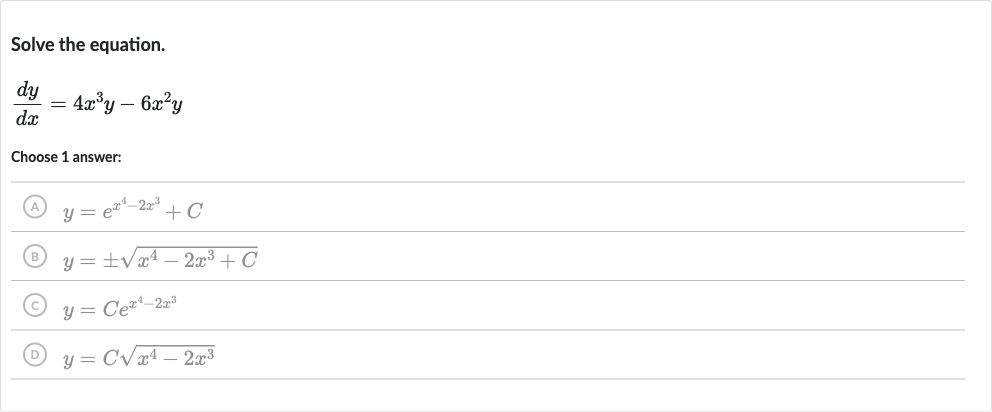AI tutor
Full solution
Q. Solve the equation.Choose answer:(A) (B) (C) (D)
- Identify Equation Type: This is a first-order linear homogeneous differential equation. We can solve it by separating variables or by recognizing it as a separable differential equation. We will use the separation of variables method.
- Separate Variables: First, we separate the variables and by dividing both sides of the equation by and by .
- Simplify Right Side: We simplify the right side of the equation by factoring out from both terms.
- Integrate Both Sides: After canceling out the common terms, we get:
- Exponentiate to Solve: Now we integrate both sides of the equation. The integral of is , and the integral of is .
- Check Answer Choices: To solve for , we exponentiate both sides of the equation to get rid of the natural logarithm.
- Check Answer Choices: To solve for , we exponentiate both sides of the equation to get rid of the natural logarithm. Since is just a constant, we can denote it as , and since can be positive or negative, we can drop the absolute value and include the constant to account for the sign.
- Check Answer Choices: To solve for , we exponentiate both sides of the equation to get rid of the natural logarithm.Since is just a constant, we can denote it as , and since can be positive or negative, we can drop the absolute value and include the constant to account for the sign.We now look at the answer choices to see which one matches our solution. is not correct because it does not match the form of our solution. is not correct because it involves a square root and our solution does not. is not correct because the exponent does not match our solution. is not correct because it involves a square root and multiplication by , which does not match our solution.
- Check Answer Choices: To solve for , we exponentiate both sides of the equation to get rid of the natural logarithm.Since is just a constant, we can denote it as , and since can be positive or negative, we can drop the absolute value and include the constant to account for the sign.We now look at the answer choices to see which one matches our solution. is not correct because it does not match the form of our solution. is not correct because it involves a square root and our solution does not. is not correct because the exponent does not match our solution. is not correct because it involves a square root and multiplication by , which does not match our solution.None of the provided answer choices match our solution . It seems there might be a mistake in the separation of variables step or in the provided answer choices.

